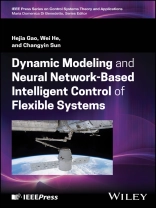Comprehensive treatment of several representative flexible systems, ranging from dynamic modeling and intelligent control design through to stability analysis
Fully illustrated throughout, Dynamic Modeling and Neural Network-Based Intelligent Control of Flexible Systems proposes high-efficiency modeling methods and novel intelligent control strategies for several representative flexible systems developed by means of neural networks. It discusses tracking control of multi-link flexible manipulators, vibration control of flexible buildings under natural disasters, and fault-tolerant control of bionic flexible flapping-wing aircraft and addresses common challenges like external disturbances, dynamic uncertainties, output constraints, and actuator faults.
Expanding on its theoretical deliberations, the book includes many case studies demonstrating how the proposed approaches work in practice. Experimental investigations are carried out on Quanser Rotary Flexible Link, Quanser 2 DOF Serial Flexible Link, Quanser Active Mass Damper, and Quanser Smart Structure platforms.
The book starts by providing an overview of dynamic modeling and intelligent control of flexible systems, introducing several important issues, along with modeling and control methods of three typical flexible systems. Other topics include:
- Foundational mathematical preliminaries including the Hamilton principle, model discretization methods, Lagrange’s equation method, and Lyapunov’s stability theorem
- Dynamic modeling of a single-link flexible robotic manipulator and vibration control design for a string with the boundary time-varying output constraint
- Unknown time-varying disturbances, such as earthquakes and strong winds, and how to suppress them and use MATLAB and Quanser to verify effectiveness of a proposed control
- Adaptive vibration control methods for a single-floor building-like structure equipped with an active mass damper (AMD)
Dynamic Modeling and Neural Network-Based Intelligent Control of Flexible Systems is an invaluable resource for researchers and engineers seeking high-efficiency modeling methods and neural-network-based control solutions for flexible systems, along with industry engineers and researchers who are interested in control theory and applications and students in related programs of study.
Tentang Penulis
Hejia Gao, Ph D, is an Associate Professor at the School of Artificial Intelligence, Anhui University, Hefei, China. Previously, she was a Visiting Researcher at the Department of Mechanical, Industrial and Aerospace Engineering, Concordia University, Canada. She has published over 30 international journal and conference papers. Her research interests include neural networks, reinforcement learning, flexible systems, and vibration control.
Wei He, Ph D, is a Full Professor at the School of Automation and Electrical Engineering, University of Science and Technology Beijing, China. He has co-authored three books and published over 100 international journal and conference papers. He was awarded a Newton Advanced Fellowship from the Royal Society, UK, in 2017. His research interests include adaptive control, vibration control, and bionic flapping wing aircraft.
Changyin Sun, Ph D, is a Professor at the School of Automation, Southeast University, Nanjing, China. He has co-authored four books and published over 160 international journal papers. Prof. Sun is a Chinese Association of Automation Fellow. His research interests include intelligent control, flight control, pattern recognition, and optimal theory.












